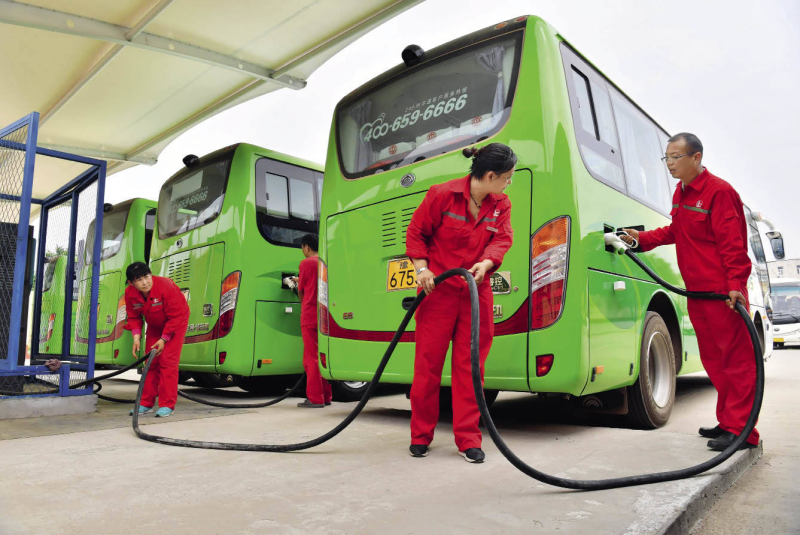
Children in a kindergarten of Lincheng Town, Changxing County, Zhejiang Province, create artwork out of waste products such as old newspapers, toothpaste boxes, and egg cartons on June 4, 2020.
As governments look to create jobs and promote economic growth in the wake of the COVID-19 pandemic, they need to make a choice in designing economic stimulus programs. They can choose more polluting, inefficient, high-carbon and unsustainable development, or they can accelerate the inevitable shift to low-carbon and increasingly affordable energy, and transport systems that will bring long-term economic and social benefits. Obviously the latter seems to be the wiser choice.
Governments and international financial institutions are mobilizing an unprecedented level of funding — already over US $10 trillion — to recover from the COVID-19 crisis. What happens during the next year or so will have a major impact on whether the world will be able to overcome the massive and urgent sustainability issues we face. We hope that governments will choose not to return to the same old way of doing business but will choose to “build back better.”
Important Lessons to Learn
These are still early days in terms of developing an understanding of the overall impact of the pandemic and the economic knock-on effect. Here are four lessons that the international community can draw from the outbreak:
First, COVID-19 is a poignant reminder that people and our economy are deeply vulnerable to risks and shocks — and that these risks are often interconnected. A health crisis can affect anyone, but we know that people who are already at risk or living in poverty are likely to suffer the most. Similarly, the economic crisis will undermine the ability of vulnerable households and communities to weather other risks, such as those related to climate change, like droughts, floods, and other disasters. COVID-19 is a “threat multiplier” and underscores the urgency of building resilience not only to pandemics but to a wide range of risks including climate change and ecosystem destruction.

Local residents jog across a wetland park of Xin’gan County in Jiangxi Province on July 3, 2020.
Second, the COVID-19 crisis shows that the world can respond to crises with speed and at scale when needed. Many countries have undertaken an unprecedented response to protect people in the face of the pandemic. As of early May, more than half of the planet’s population had been under some form of restriction of movement to prevent further spread of the virus. Already, the 20 largest economies had announced more than US $6 trillion in fiscal support and trillions more in monetary support to help people and businesses recover from the crisis. These are remarkable actions that would have been unthinkable just a few months before. In addition, some countries are showing that it is possible to respond effectively to COVID-19 and tackle the climate crisis at the same time. South Korea, for example, has combined aggressive testing with early isolation and treatment to reduce its daily infection rate, while the government further pledged to reach net zero carbon emissions by 2050 and end financial support for new coal-fired power plants. Chile has approved a more ambitious national climate plan, and has stated that it will “enter a rehabilitation phase which must be sustainable.”
Third, environmental health is directly linked to human health. For example, deforestation due to human activity breaks down barriers between animal and human populations. During the last 40 years, almost all pandemic outbreaks, such as Ebola, Middle East respiratory syndrome (MERS), severe acute respiratory syndrome (SARS), and HIV-AIDS, originated in animals and were spread by humans, posing a significant threat to global public health. With increasing urbanization, travel, and population growth, these diseases can spread quickly, overwhelm health infrastructures, and become pandemics. The impacts of climate change and associated effects on air, water, and land pollution are incredibly harmful to humanity. It is estimated that outdoor air pollution leads to 4.2 million premature deaths each year. Air pollution also contributes to underlying respiratory illnesses like asthma and chronic obstructive pulmonary disease (COPD), which are considered risk factors for COVID-19.
Fourth, an important and less explored link between the COVID-19 crisis and sustainability is the extent to which some of the behavioral changes taking place now are “sticky” (or long-lasting), and will continue beyond the crisis. Behavioral changes may include greater use of teleworking and virtual meetings instead of long-distance travel, or avoiding public transit — like trains and buses — due to health concerns. Some shifts that are good for the environment, like reduced air travel, could prove durable beyond the crisis. If some of these changes take hold, they could profoundly reshape how the world looks following the COVID-19 pandemic.
In the short term, governments are focused on the emergency health response and support for affected citizens and businesses. It would be a mistake, however, to relax important environmental and health regulations or continue to invest in high-carbon industries, such as coal production. Growing evidence shows that energy generated from renewable sources, like wind and solar, is already cheaper than that from coal in all major markets. Countries should also look to shift away from oil and gas investments and help workers’ transition to more sustainable livelihoods and more diverse economies. Governments should also explore opportunities to advance sustainable infrastructure, such as smart grids, energy-efficient buildings, public transport, electric vehicle charging stations, and nature-based systems.
China in Low-Carbon Development
China is the first country to suffer from the coronavirus outbreak, the world can learn from its experience, including how the country is moving to restart its economy. After implementing lockdown in January, China’s economy slowed down significantly. China’s first quarter GDP declined by 6.8 percent compared to the same period in 2019, the first year-on-year contraction since quarterly GDP reporting began in 1992.
As recovery and stimulus plans are carried out by central and local authorities in China, investments in a few key areas, like electric vehicle charging infrastructure, renewable energy, and healthier cities, can help move economic recovery toward a better future.
At the end of 2019, China had the largest electric car market in the world with 3.8 million electric vehicles on the road, representing five percent of annual car sales. China aims to increase annual sales of electric vehicles to 25 percent by 2025. Although China also has the world’s largest public charging network — half of the global total, gaps in charging availability still exist. Vastly increasing the charging infrastructure will be important to serve the existing vehicles, encourage consumers, and increase the share of EVs on the road.
Given the growing economic competitiveness of renewable energy, and the strong evidence of the problems associated with coal, China has an opportunity to shift toward cleaner, lower-emission energy sources. Investment in renewable energy, on the other hand, can drive low-carbon economic growth and create jobs while reducing emissions.

Staff workers of the Sinopec Zhongyuan Oilfield’s vehicle management center charging electric buses in Puyang City of Henan Province on May 16, 2018.
The coronavirus underscores the importance of building a healthy China, including the importance of creating healthy cities. In 2016, China laid out the Healthy China 2030 blueprint and a corresponding action plan, which put health as the priority of development and focus on the health of all people across China. Under this ambitious plan, China aims to reduce pollution in air, water, and soil; implement strict emissions standards for industries; improve walking, biking, exercise, and public health facilities, and promote road safety. The plan marks a significant shift in the mindset of the country: prevention is better than treatment, and health is not only about building hospitals, but keeping the population in good physical and mental condition.
Green infrastructure investments, such as planting trees and expanding urban forests, are examples of how to improve health and create economic benefits. Trees and natural areas within cities can purify the air, reduce temperatures, lower energy bills, support mental health, and build resilience to climate change. For example, the economic benefits of trees in New York City parks are estimated to be US $120 million a year, five times the annual expenditure for park maintenance. Other opportunities include expanding safe biking lanes, pedestrian walkways, and public spaces that encourage more physical activities; increasing shared transportation and micro-mobility options; installing better water and waste management systems to improve sanitation and reduce waste in addition to other initiatives.
Over the last five years, China has made significant progress on its ecological goals. It reduced air pollution in its cities, invested heavily in renewable energy, and expanded its electric vehicle fleet. More importantly, it set emissions targets and played a central role in the Paris Agreement on Climate Change. China’s 14th Five-Year Plan period (2021-2025) will offer an important opportunity for the country to further shift its development agenda toward high-quality and green development. As China prepares its 14th Five-Year Plan, especially given the COVID-19 pandemic, it can give special attention to climate change, the Belt and Road Initiative, and global supply chains.
China’s pursuit of low-carbon and resilient development is not only good for economic growth but also conducive to addressing global climate change. While formulating the 14th Five-Year Plan, China has the opportunity to set a strong target for national greenhouse gas emissions to enter “a period of stability.” Many leading Chinese provinces and cities are in a position to see greenhouse gas emissions peak even earlier. Moreover, China can also rapidly decarbonize its power sector as wind and solar will reach grid parity in perhaps a couple of years. Finally, the government can support investment in compact urban development, mass transit, more efficient use of concrete and steel, and more efficient appliances and lighting.
United to Pull Through the Crisis
The COVID-19 pandemic has fundamentally disrupted the global economy in just a few months and exposed the vulnerabilities of global value chains to rapid and unexpected changes from factors in the natural environment. The concepts of “crossing the river in the same boat” and “a community with a shared future” are precisely what the world needs to embrace to address the global health pandemic, economic slowdown, and global crisis. These global challenges can only be solved if countries work together. The problem is that many countries are moving in the opposite direction, preferring to isolate themselves from others. This is wrong. At a time of increased “social distancing,” we need more not less international cooperation. The world needs to create a more inclusive, prosperous, and sustainable future for all.
World Resources Institute is a global, independent, non-governmental research organization, with offices around the world, including in China, India, Brazil, Indonesia, Africa, the Netherlands, and the United States. We work at the nexus of the environment, economy, and human development, and focus on issues related to energy, cities, water, forests, food, and climate change. We have been aware of the emerging health crisis since January when our colleagues in Beijing began to work remotely. As the crisis expanded into a pandemic, we quickly realized that the implications would be far-reaching and long-lasting. Our approach has been to use our research and evidence to inform policy makers and strategy drafters to not only help communities recover, but also to find opportunities for governments to deliver more green, resilient, and inclusive economic growth. We see an opportunity to build back better.
___________
MANISH BAPNA is executive vice president and managing director of the World Resources Institute.